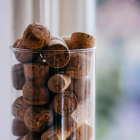Cheese and wine are a match made in heaven, but the perfect pairing is a conundrum that has perplexed dinner party hosts and cheese fans alike for years. Some subscribe to century-old schools of thought on tastes and textures, while others prefer to play it fast and loose with the supposed ‘rules’. As with so many things, of course, it all comes down to personal preference: if a bold red wine and a soft creamy cheese does it for your palate, go for it. Otherwise you can’t go wrong with these top tips.
1. Go for equal intensities
Big bold wines need to be matched with big bold cheeses, lest the flavour of either be overwhelmed by its counterpart. As a rule of thumb, wines over 14.5% ABV are more intense and therefore pair better with intensely-flavoured cheeses. Wines under 12%, meanwhile, do better with more delicately-flavoured cheese.
For example:
* Cabernet Sauvignon, Merlot and Cabernet France with Cheddar, Gouda and aged cow cheeses.
* Pinot Noir, Beaujolais and St Laurent with Gruyere, Comte and nutty cow cheeses.
2. ‘Bold and old’
Cheese becomes richer in flavour and fat content as it ages and loses water, making it an ideal match for bold red wines as the fat in the cheese nicely counteracts the high tannins in wine. Go for cheeses that have been aged for at least a year.
For example:
* Sangiovese, Brunello di Montalcino and Chianti with Grana Padano, Pecorino and Asiago.
3. ‘Sweet and smelly’
Sweet wines pair particularly well with stinky, washed-rind and blue-veined cheeses – the wine’s sweetness helps to balance out the funkiness of the cheese, and makes it taste creamier.
For example:
* Port and Stilton, Sauternes and Roquefort.
4. ‘Soft and sparkling’
Don’t shy away from introducing a bit of fizz to proceedings. Sparkling wines have a high acidity and carbonation, making for a lovely palate-cleanser against creamy, sticky cheeses.
For example:
* Champagne, Cava and Prosecco with Brie, Muenster, Camembert and Cremont.
5. Match the provenance
The oft-cited saying of ‘What grows together goes together’ is also applicable here, with wines and cheeses from the same regions often matching wonderfully.
For example:
* Sauvignon Blanc and goat’s cheese (from the Loire Valley), Chardonnay and Epoisses de Bourgogne (from Burgundy) and Garnacha with Manchego (from Spain).
6. A nutty cheese is a good all-rounder
If you’re planning on serving several wines and you’re not sure which cheeses to serve – or simply can’t be bothered with the exacting science of flavour-matching – a firm, nutty cheese is always a safe bet. It’s a popular choice that has enough fat to balance against the tannins in red wine, but enough delicacy to complement the delicacies of white wine. You won’t go far wrong with Gruyere, Emmental, Gouda or Comte.






